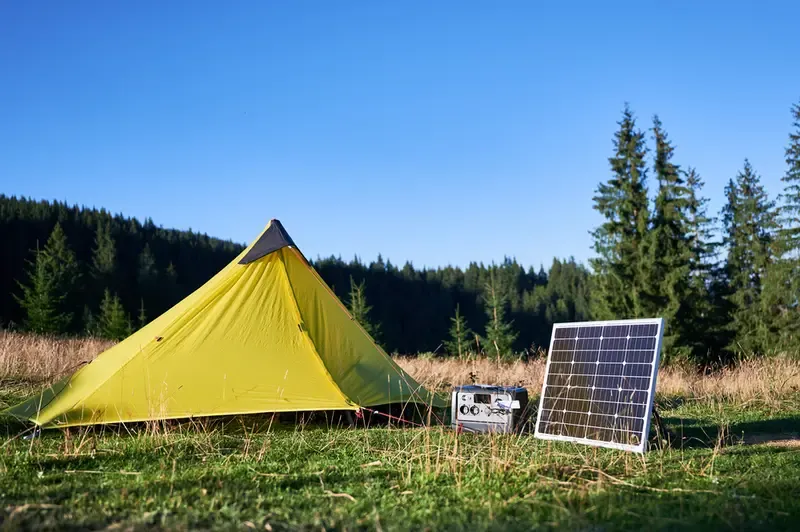How to Connect a Solar Panel to a Portable Power Station
If you’ve invested in a portable power station and suddenly find yourself wondering how to get everything up and running with a solar panel, don’t worry: you’re not alone: many people wonder, “Can I just plug my panel in and go?” The short answer: yes—but only if done properly. In this article here, we’ll discuss how to connect a solar panel to a portable power station, best practices, and answer frequently asked questions about setup, safety, and efficiency.
What Is “Connecting a Solar Panel to a Portable Power Station”?
To connect a solar panel to a portable power station is to make an accurate electrical and mechanical connection between your PV module (panel) and the storage/AC-output device. The route is: solar panel → charge controller (most often integrated) → portable power station battery bank → AC or DC output to devices.
These are basic definitions:
- Solar panel:The panel that converts sunlight into DC electricity.
- Portable power station:A built-in battery pack with an inverter and inputs (such as a “solar input”) to store and release power.
- Connection:Making sure the panel’s output is compatible (voltage, current, connector type) with the power station’s solar input and that the system is properly set up safely.
How to Connect Your Solar Panel System
1. Check Panel & Station Compatibility
Prior to plugging in, confirm these critical specs:
- Portable power station’s “solar input” voltage range. For example: some will accept 12–24 V or 10–50 V.
- Maximum current/input power the station is capable of handling (so you don’t overdo it).
- Connector types (MC4, XT60, or proprietary) must be compatible or use an adapter.
2. Position & Mount the Solar Panel
You’ll want the panel to gather as much sunlight as possible. In practice:
- Face the panel toward the sun—typically true south in the northern hemisphere—and adjust tilt based on season.
- Make sure there’s no shading from trees, buildings or equipment.
- Secure panel mount if windy; ensure wiring is safe.
3. Connect the Solar Panel to the Portable Power Station
A general process:
Turn off the portable power station or set it to standby.
Use the solar cable (or adapter) from panel output to the “Solar Input” or “DC In” port of the power station.
Ensure secure connection and check display for “solar input charging” status.
If you have more than one panel, wire them correctly in series or parallel (as per station specifications) and do not overload voltage/current limits.
Verify charging on the station display/dashboard to check power is being taken.
4. Optimize for Efficiency & Safety
To be able to harness your setup to its full capacity:
Use a Charge Controller or MPPT (Maximum Power Point Tracking) either as an integral part of the station or external to keep panel output at optimal levels.
Keep the wires short and heavy gauge to reduce losses.
Ensure ventilation and sitting of power station within temperature specifications. The majority of stations won’t work well in high heat or low temperatures.
Keep the panels clean regularly—dust and grime reduce output by 5-20%.
If you are on a remote site (e.g., an Arizona field site for researchers) make sure that you have the correct battery chemistry (Li‐ion vs LiFePO₄) and weather-rated equipment.
Why Use Solar Panel + Power Station?
Can’t you simply plug the station into AC mains?
Because solar panel + portable power station lets you have real stand-alone power—ideal for camping, off-site field work, emergency stand-by, or off-grid use. The convenience is the major draw.
Is this setup worth the hassle?
Yes—if your system involves mobility, grid-outage survivability, or remote connection. But if you plan to use it only where mains power is always available, then the extra complexity will not be worth it.
Real-World Case: Field Study Site in Arizona
A research station in Arizona used a 200 W solar panel and a 1 kWh capacity portable power station. Despite having high sunlight hours where they were, they suffered from efficiency loss when the shade or tilt of the panel changed. They monitored real input vs. predicted and needed to angle every 2 hours to improve charging by ~10%. The trick: even in high-sun locations, correct orientation and cabling are important.
Quick Checklist for Your Setup
- Check station input voltage/amp specs
- Use panel with the same voltage and maximum output
- Choose proper cable/connector (MC4, XT60, etc.)
- Mount panel with best tilt & direction
- Wire properly if using multiple panels
- Check input and station display
- Clean panel & station environment
By following these steps and asking the right questions—about compatibility, placement, wiring and system environment—you’ll be connecting your solar panel to your portable power station the right way. Enjoy reliable renewable power whether you’re off-grid, prepping for emergencies, or powering field research.

